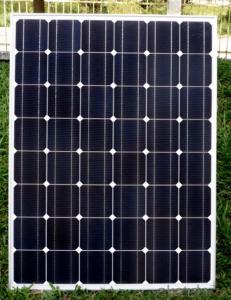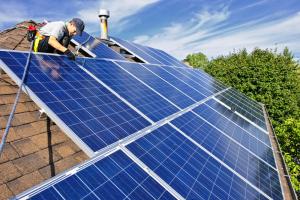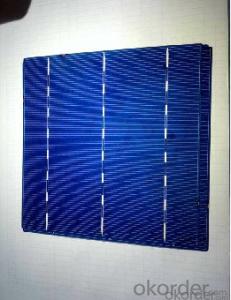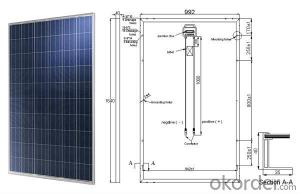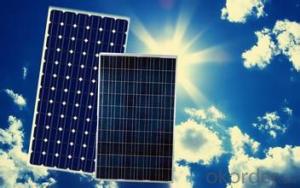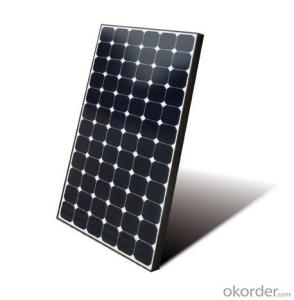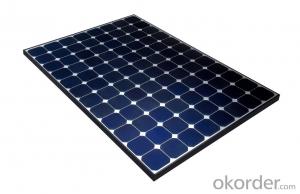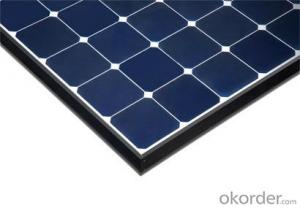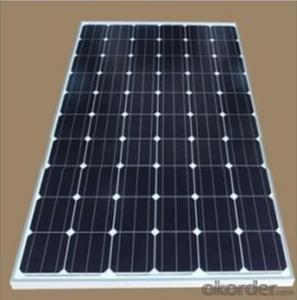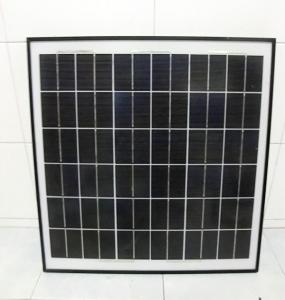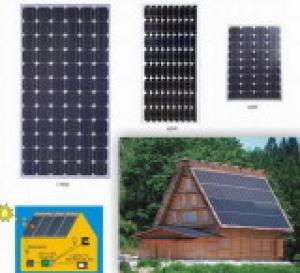100 Watt CNBM Polycrystalline Silicon Solar Panels for Home Use
- Loading Port:
- Tianjin
- Payment Terms:
- TT OR LC
- Min Order Qty:
- 100 watt
- Supply Capability:
- 1000 watt/month
OKorder Service Pledge
OKorder Financial Service
You Might Also Like
Specification
100W CNBM Polycrystalline Silicon Panel for Home Using
Production description
Most solar modules are currently produced from crystalline silicon (c-Si) solar cells made of multicrystalline andmonocrystalline silicon. In 2013, crystalline silicon accounted for more than 90 percent of worldwide PV production, while the rest of the overall market is made up of thin-film technologies using cadmium telluride, CIGS and amorphous silicon[7]Emerging, third generation solar technologies use advanced thin-film cells. They produce a relatively high-efficiency conversion for the low cost compared to other solar technologies. Also, high-cost, high-efficiency, and close-packed rectangular multi-junction (MJ) cells are preferably used in solar panels on spacecraft, as they offer the highest ratio of generated power per kilogram lifted into space. MJ-cells are compound semiconductors and made of gallium arsenide (GaAs) and other semiconductor materials. Another emerging PV technology using MJ-cells is concentrator photovoltaics (CPV).
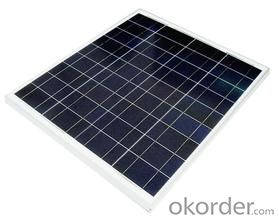
Feature
Long-term stability,reliability and performance
Low breakage rate
Color uniformaity
Physical characteristic
1. Rigorous quality control meets the highest international standards.
2. High-transmissivity low-iron tempered glass, strong aluminium frame.
3. Using UV-resistant silicon.
4. IS09001/14001/CE/TUV/UL
- Q: Are solar panels safe?
- Yes, solar panels are safe. They are designed and installed to meet strict safety standards. They do not produce any emissions, and the risks associated with solar panels are extremely low. However, it is important to ensure proper installation and maintenance to maximize safety.
- Q: Can solar panels be used in areas with high levels of rainfall?
- Yes, solar panels can be used in areas with high levels of rainfall. Rainfall does not necessarily affect the functioning of solar panels as they primarily rely on sunlight to generate electricity. However, it is important to ensure that the solar panels are properly installed and maintained to prevent any water damage or reduced efficiency caused by excessive rain.
- Q: I am curious about how much of the energy that a solar panel of a given size and capacity will produce in it's lifetime, and what fraction of that energy was required to produce it in the first place?
- The attached link is to an article from the 200 Home Power magazine. In that article the energy payback was found to be between 2 and 4 years. Newer panels are more efficient primarily because the silicon wafers used today are thinner. The silicon cell embodies most of the energy required to make a solar panel. Today most solar panels will produce the amount of energy required to manufacture them in between about 9 months and 2 years depending upon the specific technology used to make it. Solar panels are expected to produce energy for between 30 and 50 years. Therefore it takes around 5% of their total energy production to produce them. Note that these figures depend upon where the panels are installed. Panels in very sunny areas may generate more than 3 times the energy of panels in a cloudier area. Edit - The energy payback meta-study that carbonates references below mention one particular study Alsema (2000), which the authors used as a baseline to come up with their 4 year payback figure. These studies DO NOT assume ideal conditions. The Alsema study assumes an annual an irradiation of 700 kWh/m2/yr. That is the United States average irradiation and does take into account cloudy weather and the like. Under idea conditions the amount of energy collected can be almost twice as much. Albuquerque New Mexico is an example. The figures I mentioned above are recent values reported by several different panel manufacturers with whom I discussed the issue at the 2006 IEEE 4th World Conference on Photovoltaic Energy Conversion held this May. The very long payback times that carbonate highlights are almost certainly wrong. The study he references concludes that paybacks range between 2 and 8 years with 4 years being the most likely. In my opinion payback times are actually a fair bit shorter based on conversations with the manufacturers.
- Q: Hi there. I live in Colorado, and we obviously get a ton of snow there. I im looking into a solar power system for my home, and I am wondering if the snow will accumulate on the panels, or if, because of the energy passing through, it will melt on contact? By the way we get about 20' of snow each year, and it comes on often. I will also be putting them on my roof. Thanks for your help.
- In heavy snow areas, snow can build up on panels. If you mount on your roof as most people do, the angle of the panels will help the snow to slide off. Some people encourage the snow to slough off with a very long-handled squeegee or stick. You will see a drastic power reduction when the panels are covered with snow, even if it's just a few of them. However, the panels are made to take snow load, they won't be damaged. Generally, they are also designed to resist hail up to a certain size, if that's an issue where you live. I'd suggest looking in the phone book or on the internet for a local solar installer, and asking them for references close to you. You can then contact the people there and ask how it's working out for them. Also try searching for an answer on the link below. It's a solar discussion forum with very knowledgeable people.
- Q: I am looking to get some solar panels for my home to just power a few lights, a fan or two. I have a generator but I want that only to power the fridge and maybe some other small stuff for convenience.But mainly want the solar panels for the lights and fans. Any one have an idea of how about I go to figuring this all out? Should I call a contractor or anything?
- If your only deed is for power during outages, solar is not the way to go. You can add up all the wattages of the fridge and the lights you want to use, and see if the total is less than the capacity of the generator. If it is more, buying a larger generator is the answer. You can find the wattage of the fridge on the inside, or back. If not, Google the model number and manufacturer. You may already use CFL light bulbs, but if not, they can help reduce the load.
- Q: Can solar panels be installed on ground-mounted structures?
- Yes, solar panels can be installed on ground-mounted structures. In fact, ground-mounted solar panel systems are a popular choice for residential, commercial, and utility-scale projects. They offer flexibility in terms of location, orientation, and scalability, making them an ideal option for areas with limited roof space or shading issues. Ground-mounted structures can be customized to optimize solar panel angles for maximum energy production and are easier to install and maintain compared to rooftop systems.
- Q: Solar panels are expensive,can I make my own solar panel?
- Have okorder . This could definitely help you!
- Q: all i want to do is provide enough electricity for 2 fluorescent bulbs i was looking at some 80 watt panels how many of those would i need and what else do i need for storing the electricity for use at nite? and how much would it all cost?
- The solar panels are made in China because there are fewer environmental regulations and cheap coal power. It takes a lot of energy to melt silicon and there are toxic waste products. It would be three to five times more expensive to make the panels in the US ( three times is just for reprocessing the toxic wastes ). Solar cell made in China are about $2 a watt, perhaps as low as $ a watt but in truth the claims for $ a watt or less solar panels as in thin film solar panels have much lower efficiency and require perhaps ten times more surface area.
- Q: I mean when light hits the solar panel where does the energy go and what does it become? Be specific.
- In a photo-voltaic cell, the energy of the light knocks electrons loose within a semiconductor, causing electrical current to flow. see science.nasa /science-news/sci... Some other kinds of solar energy plants use lots of mirrors to focus sunlight and boil water to drive a steam turbine and generate electricity.
- Q: Can solar panels be used in areas with high levels of seismic activity?
- Yes, solar panels can be used in areas with high levels of seismic activity. However, special design considerations and installation techniques may be required to ensure their stability and withstand potential earthquake forces.
Send your message to us
100 Watt CNBM Polycrystalline Silicon Solar Panels for Home Use
- Loading Port:
- Tianjin
- Payment Terms:
- TT OR LC
- Min Order Qty:
- 100 watt
- Supply Capability:
- 1000 watt/month
OKorder Service Pledge
OKorder Financial Service
Similar products
Hot products
Hot Searches
Related keywords
